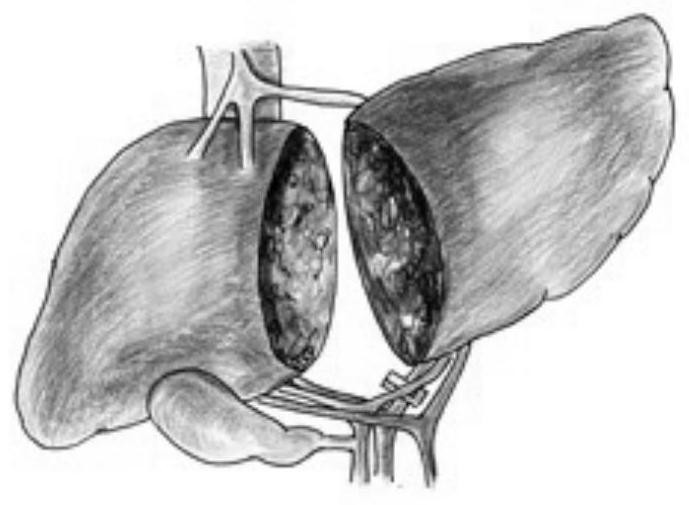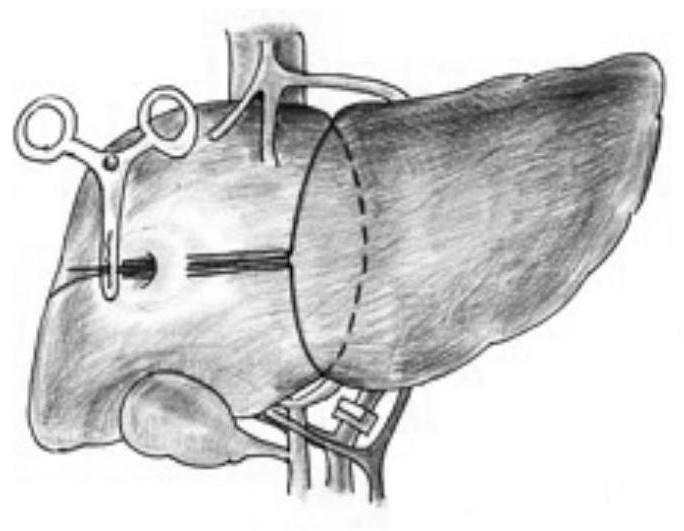Surgical method and instrument for two-step excision of patient side liverby liver winding belt method under complete laparoscope
A laparoscopic and surgical technique, applied in the fields of surgery, medical science, diagnosis, etc., can solve the problems of high incidence of bile leakage, poor recovery of physical strength, and increased adhesion in the abdominal cavity, so as to achieve less surgical trauma and reduce body immunity. The effect of the system's blow
- Summary
- Abstract
- Description
- Claims
- Application Information
AI Technical Summary
Problems solved by technology
Method used
Image
Examples
Embodiment 1
[0054] 1 clinical data
[0055] Patient, female, 61 years old. He was admitted to the hospital because of "found that AFP increased for 5 days". Past history: Suffering from chronic hepatitis B for 30 years, long-term follow-up and antiviral treatment with lamivudine and adefovir dipivoxil. "Open right hepatic nodule resection + cholecystectomy" was performed in another hospital 2 years ago, and the postoperative pathology showed coarse nodular cirrhosis and chronic atrophic cholecystitis. Admission examination: height 156cm, weight 47kg. Liver disease face, no liver palms and spider nevus, no yellow staining of skin and sclera. The abdomen was soft, without tenderness and rebound pain. After admission, the laboratory test AFP was 39.94 μg / L. Liver function Child grade A grade. Enhanced CT of the upper abdomen revealed: hepatic segment II space-occupying lesion, liver cancer, liver cirrhosis, splenomegaly, absence of gallbladder, slightly dilated intrahepatic bile duct. ...
Embodiment 2
[0075] The patient underwent "liver radiofrequency ablation" for liver cancer in a hospital in Beijing 2 years ago. After the operation, he had no obvious complaints of discomfort. The alpha-fetoprotein was checked every 3 months, and the results were normal. He entered our department for TACE two months ago, and has felt discomfort in the upper right abdomen since the operation, but has no other obvious abnormalities. Now, for further treatment, he came to our hospital for treatment. The patient suffered from chronic hepatitis B for 16 years and took 1 adefovir tablet QD.
[0076] The residual liver volume calculated by preoperative CT accounted for 35.6% of the standard liver volume. Because the remaining liver volume of cirrhotic patients is required to reach more than 40% in the future, it is planned to perform laparoscopic two-step hepatectomy around the liver band to remove the right hemi-liver.
[0077] The first phase of surgery was performed on May 22, 2014: no obvio...
Embodiment 3
[0084] This example introduces the special instrument for the two-step laparoscopic resection of the liver on the affected side according to the present invention, which is a pressure-adjustable liver tightening device.
[0085] Figure 8- Figure 12 The reference numerals in are: abdominal cavity 1, abdominal wall 2, external body 3, liver 4, liver band 5 (including first ratchet 51, base 52), abdominal wall catheter 6, pressure control device 7; pressure control device 7 includes a card Buckle 71, first sleeve 72, spring 73; buckle 71 includes second ratchet 711, second inner hole 712, protrusion 713, vernier 714; first sleeve 72 includes first inner hole 721, guide groove 722 , Scale 723.
[0086] It is a special instrument for implementing the laparoscopic two-step laparoscopic resection of the liver on the affected side. It is a pressure-adjustable liver tightening device, which includes the liver belt 5 made of flexible materials and the liver belt 5. One end is a free ...
PUM
 Login to View More
Login to View More Abstract
Description
Claims
Application Information
 Login to View More
Login to View More - Generate Ideas
- Intellectual Property
- Life Sciences
- Materials
- Tech Scout
- Unparalleled Data Quality
- Higher Quality Content
- 60% Fewer Hallucinations
Browse by: Latest US Patents, China's latest patents, Technical Efficacy Thesaurus, Application Domain, Technology Topic, Popular Technical Reports.
© 2025 PatSnap. All rights reserved.Legal|Privacy policy|Modern Slavery Act Transparency Statement|Sitemap|About US| Contact US: help@patsnap.com



